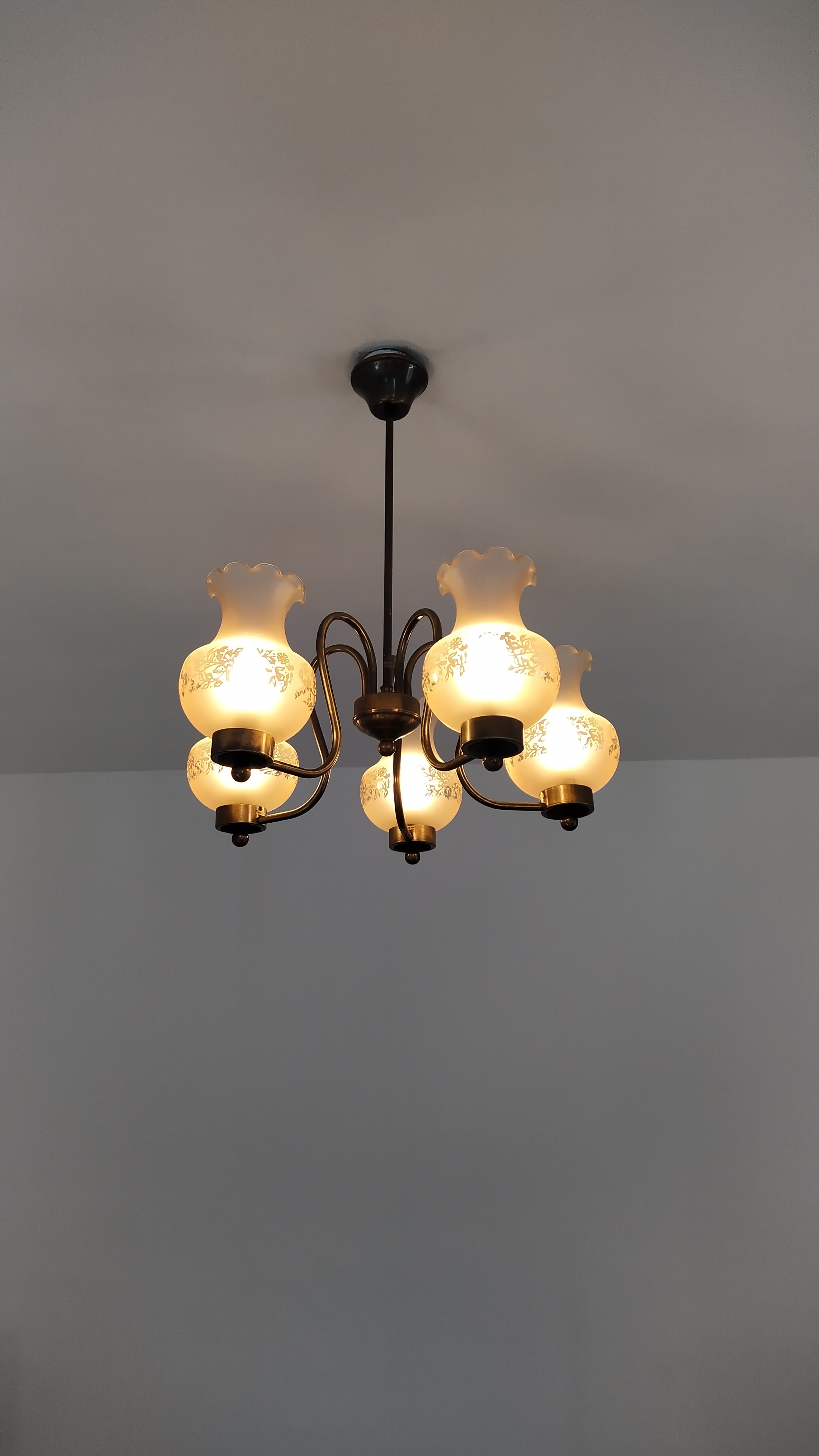Hello there.
Just joined to ask for help with my newly purchased used ceiling light.
There are 5 bulbs on the ligh and 3 wires: one red, one blue, one black. 1 build lights up when I hook the red and the blue wires to the house circuit (old house, no ground). 2 bulbs light up when I hook the black wire to the same spot as the red one. The 3 other bulds light up when I hook the black wire to the same spot as the blue one (picture). How do I get all 5 bulbs to light up together?
Thanks for your insight!
Not an electrician here but I have stayed at a Motel 6.
The blue wire is usually wired to a switch somewhere for controlling a second accessory like a fan. Seeing no fan here I dont know what the blue wire would be for It maybe set up for a kindof dim setting where some bulbs turn off?
Anyway, the black wire should go to the black house wire and the red should go to the white house wire. I would leave the blue disconnected at first while checking if this scheme works. If only some bulbs light then try to connect the blue and black to the house black.
Europe here. House wires are red and blue. Tried pairing wires of the same color: only one bulb light up…
My bad advice is even worse in Europe. Over here, we usually have two house wires plus a ground. The ground wire is bare so it’s easy to tell it from the others. The other two wires are common(white in the us) and hot(black). Most of the time you can hook a lamp up any which way you please and it will work. At this point I would go find another lamp in your hluse and pull it off the wall to compare.
Not an electrician; I’m guessing this is in Europe? Due to the block connectors and and absence of wire nuts. What was the fitting like before? Having a metal light fitting on a circuit with no earth is not safe. An amateur install may result in exposed live metal components. If you don’t have the ability to test this light and figure out which wire is which I’d call an electrician.
Thanks for the tip.
I might end up doing just that, or ditch the lamp altogether!
The three wires you describe, are they coming from the lamp or the ceiling outlet?
What wires do you have in the other side of this equation? Ie the side you didn’t describe.
Close-ups of the outlet and wires from the lamp, preferably as you found it to begin with, would be a huge help.
Yeah, sorry, not very precise. I have 3 wires coming from the light (red, blue, black) and 2 wires coming from the ceiling (red and blue). Connecting blue to blue and red to red lights up one bulb. If I add the black wire on either side, I get 2 or 3 bulbs to light up, never 5.
Sounds like you need to connect the red and blue from the lamp to one of the house wires and the black from the lamp to the other house wire.
Alrighty then. I’m not familiar with anything but Danish electrical building codes, so have that in mind when reading the following. In newer Danish installations red would be the switched wire and blue neutral. But that assumes that building codes were followed, sometimes DIY’ers will mess it up and leave you with a potentially dangerous situation.
I saw the other comment about how you could end up with parts of the lamp being shorted to 230V if you don’t know what you’re doing. I wouldn’t be so afraid any longer, if that happened you would have felt it by now ;-) besides we don’t have a history of connecting anything but protection earth to the metal part of any device, and with lamps that’s only done if it’s designed to be used in a damp environment, like a bathroom or outdoors.
I suspect that the lamp is wired so that the blue wire is neutral and connected to all the sockets, red and black are connected to 2 and 3 sockets respectively. That would allow you to turn on either 2, 3, or 5 bullbs. But it is just extremely hard to diagnose with text and pictures only.
If you disconnect and unmount the lamp, and then take a look at the sockets in the lamp. Can you tell which wires goes where?
Do you have a way of measuring continuity? Like a multimeter?
Have you tried switching bulbs around? Maybe some are burned out?
Thanks a lot for taking the time to go be me so much information.
I started with switching the bulbs and that’s all right
Having no ground wire coming from the ceiling, I am definitely not going to attach any wire to the body of the light.
I think I will try to attach the blue wire on one side and red and black together on the other side, maybe it will work ?
I could disassemble the light to inspect which wire goes to which socket but I’m not sure I could put it back together again.
Anyway, thanks a lot
Thanks a lot for taking the time to go be me so much information.
Don’t mention it. It’s a mental challenge for me to diagnose this problem with only text. And I like a challenge.
I started with switching the bulbs and that’s all right
Just to make sure, you have 5 sockets AND 5 known good bulbs? Ie you are sure that all bulbs are working?
I think I will try to attach the blue wire on one side and red and black together on the other side, maybe it will work ?
Maybe. I’m fairly certain that the lamp is wired such that
- one wire is common for all sockets. The common wire is the one you’ll want to connect with the blue wire in the ceiling outlet.
- the other wires are going to 2 and 3 sockets respectively.
The question is just, which wire is which?
I’ve seen black used for neutral in a 1950s installation in DK.
If you’re up for it, I propose that you test it systematically. We need to figure out which wire need to be separate from the others. Start by enumerating the bulbs.
I’m going to shorten the names of the wires, lr, lba, and lbu. L for lamp, r for red, ba for black, and bu for blue. Same for ceiling wires, cr and cbu.
Which bulbs light up when you attach
- lr and lba to cr and lbu to cbu? (I think you mentioned one bulb in this case? I’m not able to go back and find it while writing the comment in this app.)
- lr and lbu to cr and lba to cbu?
- lba and lbu to cr and lr to cbu? (Which you did reversed, but it’s the same, and you said two or three bulbs?)
I’ll bet that in one of these cases all the bulbs will light up. And that will be the way to wire the lamp up.
If none of the three combinations lights up all bulbs, then either the lamp is faulty, or my own bulb is :-)
Issue is I can’t see any color for the ceiling wires (only one or two cm of wire, hooked directly into the connector), so I’ll use C1 for ceiling one and C2 for ceiling 2. Lba makes the switch:
- first picture is Lr+Lba on c1, Lbu on c2, two bulbs lit
- second picture is Lr on c1, Lba and Lbu on c2, three other bulbs lit.


I don’t think switching c1 and c2 will make any difference.
I am wondering if black shouldn’t go to both ceiling wires…
Definitely get lba connected to one wire, and lbu and lr to the other. Lba is the common wire, get that alone and all the bulbs will light up.
Differences between the wires in the ceiling is that one is switched live and the other is neutral.
It may be pedantic, but lba connects to the side of the sockets, which is more easy to touch. That’s why I would connect that to neutral. But if you can’t see the wires in the ceiling, then it doesn’t matter that much.
We’re on my friend! Cheers!

I’ll try just that and update

